Free printed copies of pest alerts are available.
Origin and Distribution
The spotted lanternfly is an invasive sap-feeding planthopper, first discovered in the United States in Berks County, Pennsylvania in 2014. Field observations indicate that the tree of heaven, Ailanthus altissima, is an important host plant; however the spotted lanternfly is known to feed on a wide range of hosts including wild and cultivated grapes, stone fruits, willow, and various hardwoods. This species is thought to be native to China, and has spread to other Asian countries. In 2004, it was first detected in Korea, where its populations expanded and it became an economically important pest of grapevines and fruit trees. In Korea, it damaged plants directly by phloem feeding, but also caused indirect damage due to mold that grew on honeydew excretions deposited on the leaves and fruits of host plants. It was recorded utilizing 67 host plant species in Korea, many of which also occur in the U.S. Given the wide range of hosts it feeds upon, the spotted lanternfly poses a serious economic threat to multiple U.S. industries, including viticulture, fruit trees, ornamental plants and timber.
Life Cycle and Identification
The spotted lanternfly population overwinters as egg masses and has a one year life cycle. In Pennsylvania, the first nymphs hatch in late April to early May and are less than 1/4 inch long. Nymphs develop through four stages, all of which are wingless and incapable of flight. The first three nymphal stages are black with white spots and appear “tick-like.” Fourth instars develop red patches on the body and are over 1/2 inch long. Adults begin to appear in mid-July and are approximately one inch long and 1/2 inch wide, with wings folded. The forewing is gray with black spots near the base, and the tips are black with a dense series of lighter gray crossveins. The hindwings are bright red at the base, and have an adjacent region that is black with a white band. The abdomen is yellow with black bands down the center.
Third and fourth instars and adults migrate to tree of heaven as a preferred host. Adults mate in late summer to early fall in Pennsylvania and form large congregations. Although these have been observed on grapevine, willow, maple, and other tree species, they most commonly occur on tree of heaven. Females lay eggs from late September through October and dozens of egg masses can be found near adult aggregations. Eggs are deposited on tree trunks, limbs, and loose bark as well as any smooth surface, including stone, vehicles, trash barrels, outdoor furniture, and other man-made structures. Newly laid egg masses have a gray, mud-like covering, which can become dry and cracked over time. Old egg masses appear as four to seven columns of seed-like eggs, 30–50 eggs in total, approximately one inch long.
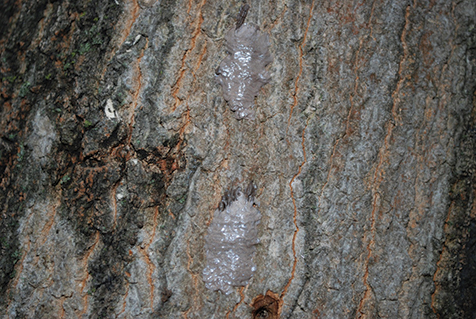
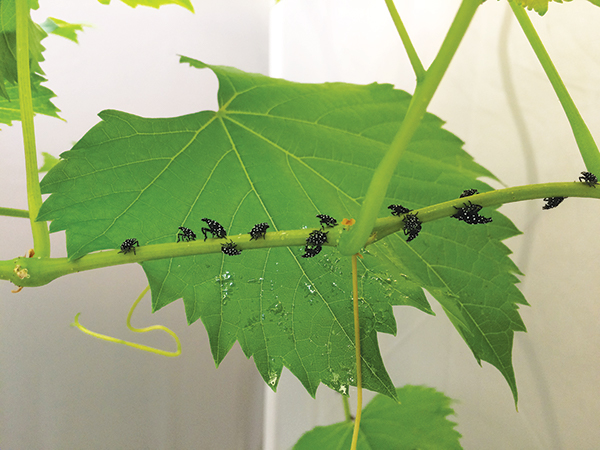

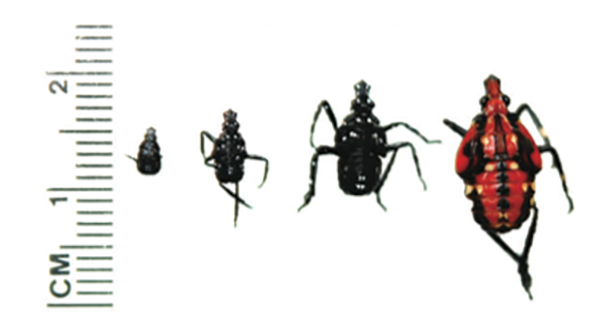
Potential Spread and Impact
Given that egg cases are deposited on such a wide variety of surfaces, this is the life stage that may have the greatest potential for spread via accidental transport to new areas. As of December 2016, the spotted lanternfly has been detected only in the southeastern region of Pennsylvania, specifically in areas surrounding Berks County.
Nymphs are flightless and may pose less of a threat for spread. However, they have been observed feeding upon over 30 species of host plants in Pennsylvania, demonstrating the spotted lanternfly is mobile and capable of dispersing to some degree as immatures. The primary host, tree of heaven, is itself an introduced invasive species that occurs throughout much of the U.S. It is considered an edge species and grows quickly in disturbed sites, including along roadways and powerline corridors. As such, corridors of tree of heaven may provide opportunities for spotted lanternfly to spread.
Although adults are capable of flight, they are relatively weak flyers, relying instead on strong jumping to evade danger. Mated females pose a high risk for establishing new populations by accidental transportation on vehicles, such as open bed trucks, and introduce their offspring to new areas. Infested municipalities are under a quarantine that covers all living life stages of the pest and its conveyances.
Trees of heaven fed upon by congregations of adults may exhibit weeping of sap along the trunk as well as build ups of honeydew excrement. Black sooty mold fungus grows on the honeydew on the tree as well as on surrounding soil and understory plants. Weeping sap and/or honeydew build ups attract ants, bees, wasps, hornets, and flies.

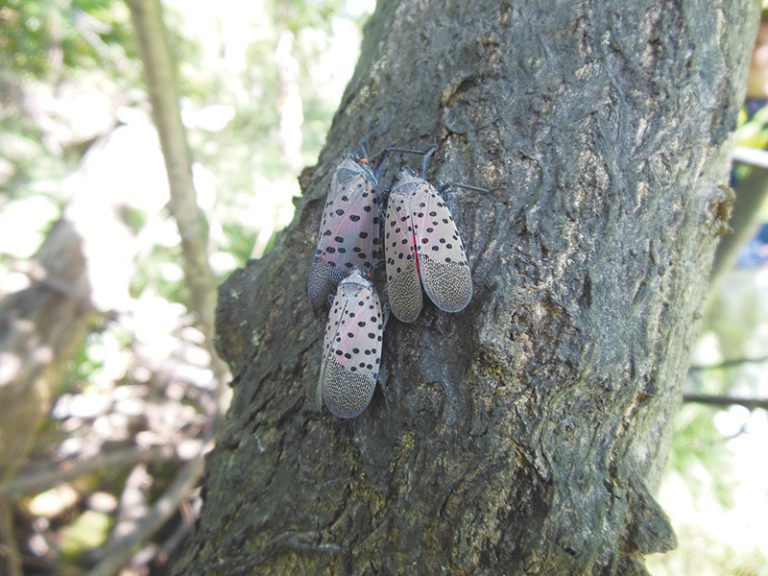
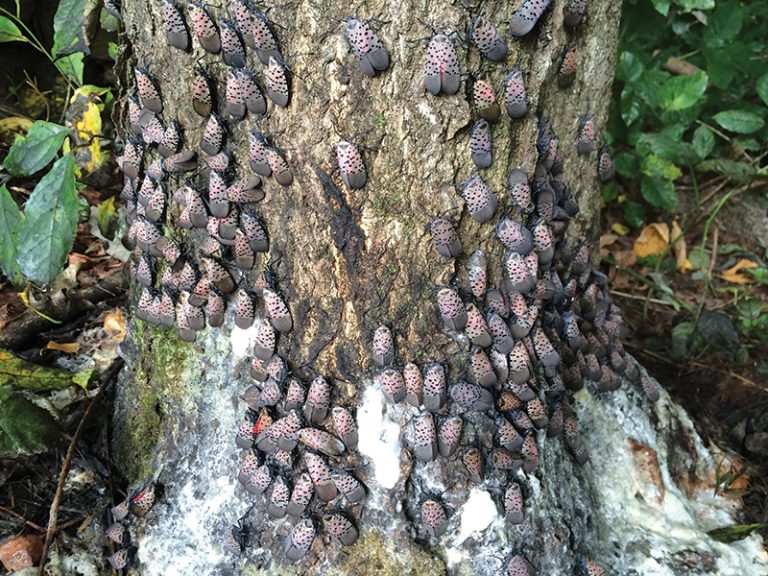
Management
Management efforts are targeted at multiple life stages of the spotted lanternfly. Egg masses can be scraped off of surfaces where they are found. Brown sticky bands are effective in catching nymphs on trees. Adults are controlled using a combination of Ailanthus host reduction and establishment of trap trees treated with systemic insecticide, which has shown to be capable of removing significant numbers of adults in the population.
Reporting
Early detection is vital to the control of spotted lanternfly. If you find an insect or egg case that you suspect is a Spotted Lanternfly, you should collect it and immediately report it to authorities. Place the insect or egg case into a container of alcohol to kill and preserve it. Egg cases can also be collected into a ziplock bag and killed with hand sanitizer. It is important to record where you found the insect and include the following information for each sample collected: date; substrate found on (e.g., species of tree, or for egg case, structure it was found on); collector’s name; phone number; collection location including state, county, and address or nearest intersection; GPS coordinates, if available.
To report the finding in Pennsylvania, report it to the Pennsylvania Department of Agriculture by emailing to: Badbug@pa.gov. Outside of Pennsylvania, call the Invasive Species Hotline: 1-866-253-7189, report to Badbug@pa.gov or contact your local Extension office.
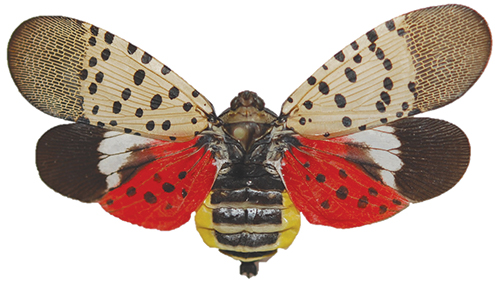
For more information on this pest, its management and quarantine in Pennsylvania, please see https://www.agriculture.pa.gov/Plants_Land_Water/PlantIndustry/Entomology/spotted_lanternfly/Pages/default.aspx
Credits
Authors
Julie M. Urban, Department of Entomology, Pennsylvania State University
Erica Smyers, Department of Entomology, Pennsylvania State University
Lawrence Barringer, Pennsylvania Department of Agriculture
Sven-Erik Spichiger, Pennsylvania Department of Agriculture
This work is supported by the Crop Protection and Pest Management Program (2014-70006-22486) from the USDA National Institute of Food and Agriculture.
For information about the Pest Alert program, please contact the North Central IPM Center at northcentral@ncipmc.org.
December 2018

